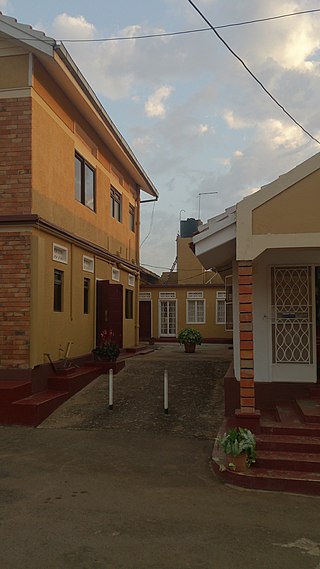Kanungu is a town in the Western Region of Uganda. It is the location of the district headquarters for Kanungu District.

The Ugandan water supply and sanitation sector made substantial progress in urban areas from the mid-1990s until at least 2006, with substantial increases in coverage as well as in operational and commercial performance. Sector reforms from 1998 to 2003 included the commercialization and modernization of the National Water and Sewerage Corporation (NWSC) operating in cities and larger towns, as well as decentralization and private sector participation in small towns.

Mityana, is a town in the Central Region of Uganda. It is the main municipal, administrative, and commercial center of Mityana District, as well as the location of the district headquarters.
The Kampala–Jinja Highway is a road in Uganda, connecting the cities of Kampala and Jinja. Sometimes referred to as Kampala–Jinja Road, it is a busy road, with several towns, trading centers and other points of interest along the way. As of October 2016, a new, wider, four-lane dual carriageway expressway, the Kampala–Jinja Expressway, is proposed to be constructed south of the present highway to relieve traffic and complement existing transport infrastructure between Kampala and Jinja.
Ggaba is a neighborhood within the city of Kampala in the Central Region of Uganda.
The National Water and Sewerage Corporation (NWSC) is a water supply and sanitation company in Uganda. It is wholly owned by the government of Uganda.
Muyenga is a hill in Kampala, the capital of Uganda and the largest city in that country. The name also applies to the upscale community that sits on that hill.

Katosi is a town in the Mukono District of the Central Region of Uganda. The town is an urban center under Mukono District Administration.
Namataba is a town in Mukono District, Central Uganda. The town is an urban center under Mukono District Administration.
Kiruddu General Hospital, also known as Kiruddu General Referral Hospital, is a hospital in Uganda. It is an urban, public, general hospital. It cost an estimated US$10.3 million plus about $350,000 in supervisory fees to build. The hospital was constructed by the government of Uganda, with funding from the African Development Bank (AfDB) and the Nigeria Trust Fund (NTF). The hospital opened to the public on 16 May 2016.
The Mukono–Kyetume–Katosi–Nyenga Road is a road in the Central Region of Uganda, connecting the towns of Mukono, Kyetume and Katosi in Mukono District to Nkokonjeru and Nyenga in Buikwe District.
Parombo is a town in the West Nile sub-region of the Northern Region of Uganda.

Sonde, also Ssonde, is a settlement in Mukono District, in Uganda's Central Region.
Bugoloobi Wastewater Treatment Plant (BWTP), also Bugoloobi Sewerage Treatment Plant (BSTP), is a wastewater treatment project in Uganda. It is the largest wastewater treatment plant in the countries of the East African Community, and capable of processing 45,000,000 liters (45,000 m3) of wastewater daily.
The Tondeka Metropolitan Kampala Bus Service (TMBS), is the proposed principal public transport operator in the Kampala metropolitan area. Expected to start in September 2020, the bus system, Tondeka Metro, proposes to serve the city of Kampala, Uganda's capital, the city of Entebbe, including Entebbe International Airport, Buloba, Nsangi, Ssabagabo, Mukono, Kira Town, Matugga, Wakiso, and the areas in Mukono District and Wakiso District that connect with these urban centers.
Busia Water Supply and Sanitation Project (BWSSP), also Busia Water Supply and Sewerage System is a water intake, purification, distribution and waste water collection and disposal system in Busia District, Uganda.
Gulu Water Supply and Sanitation Project (GWSSP), also Gulu Water Supply and Sewerage System, is a water intake, purification, distribution and waste water collection and disposal system in the city of Gulu, the largest urban centre in the Northern Region of Uganda. In October 2020, the Uganda government concluded Phase 1 of the improvement of water supply and sanitation in the city, with funding from the World Bank, KfW and the Government of Uganda. Phase 2 improvements are expected to start in 2021, with funding from the World Bank, KfW and the Commonwealth Development Corporation.
Isingiro Water Supply and Sanitation Project (IWSSP), also Isingiro Water Supply and Sewerage System is a water intake, purification, distribution and waste water collection and disposal system in Isingiro District, in the Western Region of Uganda. The project is intended to meet the water supply and sanitation needs of 340,000 people of the 550,000 inhabitants of the district. The beneficiaries include the 100,000 occupants of Nakivale Refugee Settlement and the 32,000 occupants of Oruchinga Refugee Settlement. The work is to be carried out by the Uganda Ministry of Water and Environment through the parastatal utility company, National Water and Sewerage Corporation (NWSC). Funding, have been provided by the French Development Agency and the European Union.
Masaka–Mbarara Water Supply and Sanitation Project (MMWSSP), is a water intake, purification, distribution and waste water collection and disposal system in the cities of Masaka and Mbarara in the Central Region and the Western Region of Uganda. The project is intended to meet the water supply and sanitation needs of approximately 1,055,000 by 2030. The work is to be carried out by the Uganda Ministry of Water and Environment through the parastatal utility company, National Water and Sewerage Corporation (NWSC). Funding, have been provided by the French Development Agency and the European Union.
Rukungiri Water Supply and Sanitation Project (RWSSP), also Rukungiri Water Supply and Sewerage System, is a water intake, purification, distribution and waste water collection and disposal system in the town of Rukungiri, in the Western Region of Uganda. When completed, the system is expected to supply 9,600 cubic meters (9,600,000 L) of water daily, to about 120,000 people in the town of Rukungiri and neighboring communities in Rukungiri District and to parts of Ntungamo District. The infrastructure development project is being jointly funded by the World Bank and the Government of Uganda.





